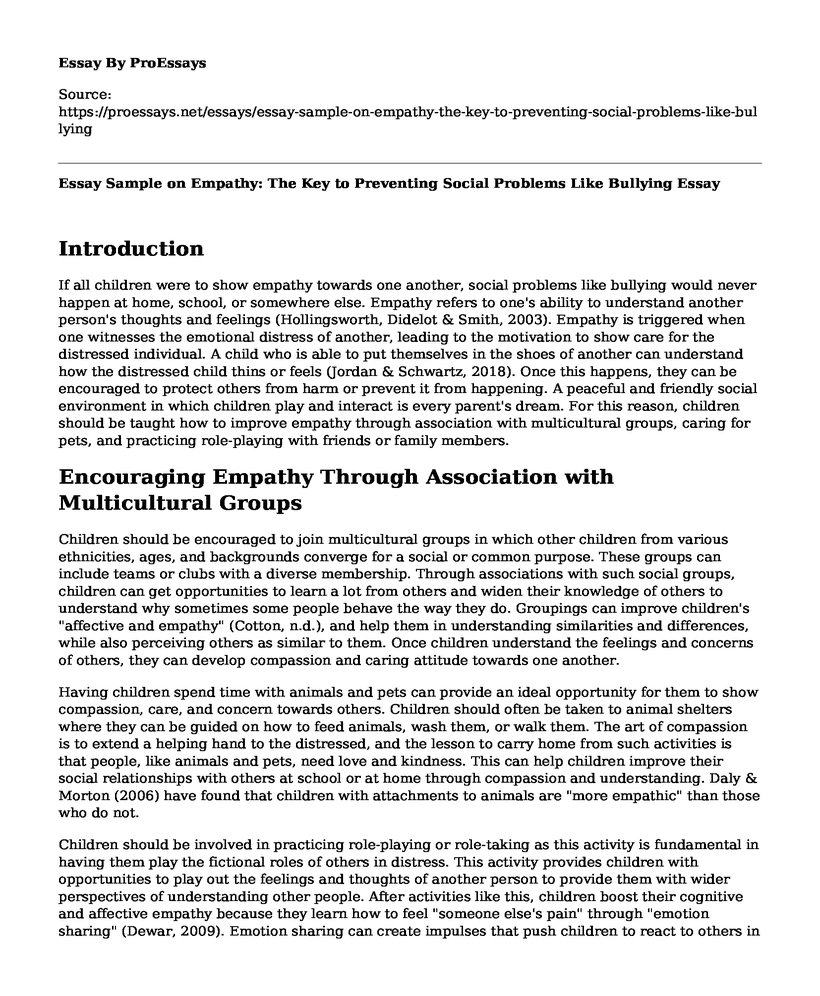Introduction
If all children were to show empathy towards one another, social problems like bullying would never happen at home, school, or somewhere else. Empathy refers to one's ability to understand another person's thoughts and feelings (Hollingsworth, Didelot & Smith, 2003). Empathy is triggered when one witnesses the emotional distress of another, leading to the motivation to show care for the distressed individual. A child who is able to put themselves in the shoes of another can understand how the distressed child thins or feels (Jordan & Schwartz, 2018). Once this happens, they can be encouraged to protect others from harm or prevent it from happening. A peaceful and friendly social environment in which children play and interact is every parent's dream. For this reason, children should be taught how to improve empathy through association with multicultural groups, caring for pets, and practicing role-playing with friends or family members.
Encouraging Empathy Through Association with Multicultural Groups
Children should be encouraged to join multicultural groups in which other children from various ethnicities, ages, and backgrounds converge for a social or common purpose. These groups can include teams or clubs with a diverse membership. Through associations with such social groups, children can get opportunities to learn a lot from others and widen their knowledge of others to understand why sometimes some people behave the way they do. Groupings can improve children's "affective and empathy" (Cotton, n.d.), and help them in understanding similarities and differences, while also perceiving others as similar to them. Once children understand the feelings and concerns of others, they can develop compassion and caring attitude towards one another.
Having children spend time with animals and pets can provide an ideal opportunity for them to show compassion, care, and concern towards others. Children should often be taken to animal shelters where they can be guided on how to feed animals, wash them, or walk them. The art of compassion is to extend a helping hand to the distressed, and the lesson to carry home from such activities is that people, like animals and pets, need love and kindness. This can help children improve their social relationships with others at school or at home through compassion and understanding. Daly & Morton (2006) have found that children with attachments to animals are "more empathic" than those who do not.
Children should be involved in practicing role-playing or role-taking as this activity is fundamental in having them play the fictional roles of others in distress. This activity provides children with opportunities to play out the feelings and thoughts of another person to provide them with wider perspectives of understanding other people. After activities like this, children boost their cognitive and affective empathy because they learn how to feel "someone else's pain" through "emotion sharing" (Dewar, 2009). Emotion sharing can create impulses that push children to react to others in distress and in need of help. It can also prevent a child from bullying another or causing them harm.
Conclusion
In conclusion, children should be taught how to show empathy towards one another in various settings, including at school and at home. Empathy-improving activities are numerous, including having children associated with diverse groups or clubs in which they can learn, visiting animal shelters and caring for pets, and having them undertake role-playing activities. These strategies can provide children with ideal conditions and opportunities to learn about other people and the importance of compassion. With a deeper and well-founded understanding among themselves, social issues like bullying, harassments and teasing among children would be greatly reduced. This reduction would create safe and friendly spaces in which children can develop and flourish into well-behaved and responsible people.
References
Cotton, K. Developing Empathy in Children and Youth [Ebook] (pp. 1-18). educationnorthwest.org. Retrieved from https://educationnorthwest.org/sites/default/files/developing-empathy-in-children-and-youth.pdf
Daly, B., & Morton, L. (2006). An investigation of human-animal interactions and empathy as related to pet preference, ownership, attachment, and attitudes in children. Anthrozoos, 19(2), 113-127. doi: 10.2752/089279306785593801
Dewar, G. (2009). Teaching empathy: Evidence-based tips. Retrieved 2 December 2019, from https://www.parentingscience.com/teaching-empathy-tips.html
Hollingsworth, L., Didelot, M., & Smith, J. (2003). REACH Beyond Tolerance: A Framework for Teaching Children Empathy and Responsibility. The Journal Of Humanistic Counseling, Education And Development, 42(2), 139-151. doi: 10.1002/j.2164-490x.2003.tb00002.x
Jordan, J., & Schwartz, H. (2018). Radical Empathy in Teaching. New Directions For Teaching And Learning, 2018(153), 25-35. doi: 10.1002/tl.20278
Cite this page
Essay Sample on Empathy: The Key to Preventing Social Problems Like Bullying. (2023, Mar 12). Retrieved from https://proessays.net/essays/essay-sample-on-empathy-the-key-to-preventing-social-problems-like-bullying
If you are the original author of this essay and no longer wish to have it published on the ProEssays website, please click below to request its removal:
- Essay on Reducing Stress in the Workplace
- SAP Evaluation and Data Management Paper Example
- Dealing With Grief and Loss Essay Example
- Essay Sample on Racism in the American Healthcare System
- Paper Example on College Students: Unequal Impact of Issues
- Essay Example on California Psychological Inventory (CPI) Assessment: Enhancing Performance
- Essay on Understanding Consumer Behavior: My Food Choices and Strategies for Informed Purchases







